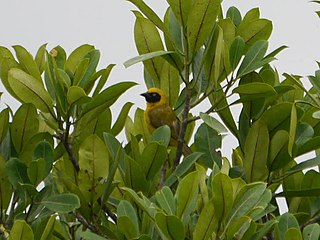
The conservation status of a group of organisms indicates whether the group still exists and how likely the group is to become extinct in the near future. Many factors are taken into account when assessing conservation status: not simply the number of individuals remaining, but the overall increase or decrease in the population over time, breeding success rates, and known threats. Various systems of conservation status exist and are in use at international, multi-country, national and local levels as well as for consumer use.

Notiosorex cockrumi, also called Cockrum's gray shrew or Cockrum's desert shrew, is a tiny species of shrews named in 2003. This red-toothed shrew, which is as light as a penny, is the first new mammal species from Arizona since 1977. Its range extends from Arizona to central Sonora, Mexico.

A species that is extinct in the wild (EW) is one that has been categorized by the International Union for Conservation of Nature as known only by living members kept in captivity or as a naturalized population outside its historic range due to massive habitat loss.
Abarema lehmannii is a species of legume in the family Fabaceae. It is endemic to the Cordillera Central in Antioquia, Colombia. It can be found at the margins of humid montane forests.
Zygia lehmannii is a species of legume in the family Fabaceae. It is found only in Colombia.
Mutisia lehmannii is a species of flowering plant in the family Asteraceae. It is found only in Ecuador. Its natural habitats are subtropical or tropical moist montane forests and subtropical or tropical high-altitude shrubland. It is threatened by habitat loss.
Pappobolus lehmannii is a species of flowering plant in the family Asteraceae. It is found only in Ecuador. Its natural habitat is subtropical or tropical dry shrubland. It is threatened by habitat loss.

Bannerman's weaver is a species of bird in the weaver family, Ploceidae. It is found in Cameroon and Nigeria. Its natural habitat is subtropical or tropical moist montane forests. It is threatened by habitat loss.

The Somali hedgehog is a species of mammal in the family Erinaceidae. It is endemic to Somalia and Somaliland. The Somali hedgehog is nocturnal.

The Bornean water shrew is a species of mammal in the family Soricidae. It is endemic to Malaysia. Its natural habitat is rivers. It is threatened by habitat loss.
Aiouea lehmannii is a species of plant in the family Lauraceae. It is found in Brazil and Colombia.
Blechnum petiolare is a species of fern in the family Blechnaceae. It is endemic to Ecuador and known only from Bolívar Province. When it was first described in the early 20th century, it was known from Chillanes but this area has been heavily disturbed and the species continues to be threatened.
Fuchsia lehmannii is a species of plant in the family Onagraceae. It is endemic to Ecuador.
Iochroma lehmannii is a species of plant in the family Solanaceae. It is endemic to Ecuador, specifically in the Chimborazo Province in the High Andes. Its flowers are yellow-green.
Lysipomia lehmannii is a species of plant in the family Campanulaceae. It is endemic to Ecuador. Its natural habitats are subtropical or tropical moist montane forests and subtropical or tropical high-altitude grassland. It is threatened by habitat loss.
Oreopanax lehmannii is a species of plant in the family Araliaceae. It is endemic to Ecuador. Its natural habitats are subtropical or tropical moist montane forests and subtropical or tropical high-altitude shrubland. It is threatened by habitat loss.
Peperomia lehmannii is a species of plant in the family Piperaceae. It is endemic to Ecuador.
Ribes lehmannii is a species of plant in the family Grossulariaceae. It is endemic to Ecuador. Its natural habitats are subtropical or tropical moist montane forest, subtropical or tropical high-altitude shrubland, and subtropical or tropical high-altitude grassland.
Saurauia lehmannii is a species of plant in the Actinidiaceae family. It is endemic to Ecuador. Its natural habitats are subtropical or tropical moist lowland forests, subtropical or tropical moist montane forests, and subtropical or tropical high-altitude shrubland. It is threatened by habitat loss.

Encephalartos lehmannii is a low-growing palm-like cycad in the family Zamiaceae. It is commonly known as the Karoo cycad and is endemic to South Africa. The species name lehmannii commemorates Prof J.G.C. Lehmann, a German botanist who studied the cycads and published a book on them in 1834. This cycad is listed as near threatened in the IUCN Red List of Threatened Species.






